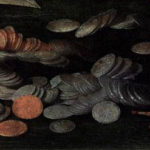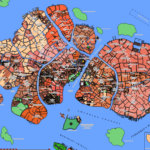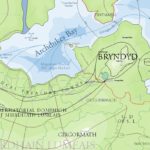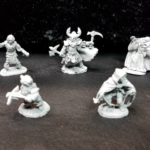The heart of a fantasy city is the map. I do love maps and a city map is a deceptively easy gaming aid that conveys all sorts of information. Over the past years, I have been working on city maps for Aurice, Trevirs, Bryndyd, Johaulia, and Aturoksha (Addinoro). Last year, IIRC, I started Aturoksha and this year, I completely revised the map for Johaulia.
Not a single one of these city maps is complete or even near complete. They are significantly larger than typical cities in a D&D world, but smaller than cities of our modern Earth. These Asdaran Cities are set in the 28th century of the World of Asdar (ca 2735). This is a time of dragonrail and titanships and comparable in many regards with the steampunk setting. However, I prefer to call this particular version of developing technology in a fantasy setting, “titanpunk.”
In the spirit of traditional D&D, most every city potentially if not secretly has a warren of tunnels and lairs underneath its open city streets.

AURICE
Aurice is an imperial capital inspired by the medieval city of Venice. It rests on thousands of islets connected by foot-bridges and canals in lagoon east of Goscundy in Lucacia. In the 28th century, Aurice is densely packed with numerous neighborhoods and districts. The Senate and various organs of government are found in or near Aurice. Dirigible-like skyships loom overhead and small aerobarges with commuters dart above the canals at the same height as the highest buildings. In the canals, merchant barges and gondolas ferry about the unending stream of inhabitants and visitors.
Titancraft is a key industry of Aurice and the city’s flat layout on the sea lends itself readily to dazzling armadas of both titanships of the sky above and titanships of the sea below. Several corpora mercia, business firms similar to corporations, labor to improve titancraft manufacturing and produce the latest that the developing technology can provide in the 28th century. The high, masonry-brick factories where titancraft components among other manufactured goods are produced are a telltale sign of an advancing age of progress.
Aurice is famous for its spectacular annual games on Summer Solstice to celebrate the new common year. Tourists and enthusiasts from all over the Pallathantic Region cram the streets and canals to watch the Imperial Skar Pennant where doughty riders on the backs of enormous, aquatic reptiles called gibgibsews (“jibs”) fight over control of a soggy dragonhide ball in the grand canal of the city. Gambling is rampant and riots sometimes erupt in the aftermath of the match. Visitors are advised to seek safe haven during these times as the city gendarmerie are typically stretched to the limits and unable to prevent crimes when the population has swollen to well over double its normal amount.
Under Aurice
You may suppose that a city resting on islets in a lagoon could not possibly harbor a subterranean counterpart. You would be wrong. Beneath Aurice, there are said to be the refuges of ancient Incarnandists who fled to the depths during the oppressive reign of the Dark Prince in the Middle Ages of Chaos. While the city administrators have continually stopped up entrances to Under Aurice, adventurers in the plentiful taverns of Aurice are well-known to believe that access to the Deepearth, specifically the realm of Kvarraga rests in Under Aurice.
You can see a PDF map of Aurice here.
BRYNDYD
The capital of the Archduchy of Bryndyd rests in the province of Heart-of-Asbardy on a peninsula across the harbor from the delta of the Rhaunve River. In deep antiquity, giants built a fortress here so as to command river traffic and rule the hinterland of southwestern Pytharnia. Today Bryndyd is the seat of government of the Archduchy of Bryndyd.
Bryndyd is famous for its dragonriders, high-spired castles, and devotion to the Arathracian Religion. Bryndyd is not only the capital of the Archduchy in southwestern Pytharnia, but also the colonial capital of New Pytharnia in southern Bahuna.
Titancraft factories are plentiful in some wards of Bryndyd.
There are two maps of Bryndyd. The first shows the core districts of the city and the second shows a great swath of the Heart-of-Asbardy, revealing the numerous villages and towns sprawling around Bryndyd and hints at the commanding position of the capital city.
Central Bryndyd
Greater Bryndyd
TREVIRS
Trevirs is the historic capital of Magdala and one of two capitals of the modern Empire of Magdala. As one of the the largest cities in the West, it is really a fusion of several small neighboring towns atop a broad hill of the northeastern highlands of Magdala (Pytharnia). Forty two boroughs comprise this vast city, most within the walls of historic Trevirs.
It is impossible to say that Trevirs is the most beautiful of cities. Many neighborhoods are indeed little more than squalor and filth. But the rich have their fine palaces and merchants their swanky dens in the best and better neighborhoods of this vast city.
Trevirs is not an easy city for immigrants. Despite this, there are many decent, hard-working Trevirites. While humans are the dominant inhabitant, halflings, dwarves, and giants comprise most of the several minority populations. Very rarely, one may encounter an elf, a lizardman, or a troll. The ratfolk are considerable, too, but conceal their true numbers in the Dragonneath.
Factories for titancraft and powered by titancraft are found throughout Trevirs but especially in some more dismal neighborhoods surrounded by the tenements and hovels of the poor who came to the city to avoid the agricultural work that is slowly diminishing in southern Pytharnia, perhaps due to the introduction of the Grand Shadew Canal. Trevirs is famous or perhaps infamous for its numerous textile mills that produce affordable woolens and linens. These textile mills are powered by titancraft or in some instances, steam.
Trevirs has great political significance. The Palace of the Imperial Diet lies towards the center of the sprawling city. Historically, the representatives of the three member states of the Union of Pytharnia have met here. Additionally, the powerful Sovereign Archguild of Master Titancrafters of Pytharnia has its headquarters in Trevirs. The Holy See of the Pytharnian Sunfather was once located in Trevirs and it remains an important bulwark of the Arathracian Church.
Dragonneath
The depths of Trevirs are known as the ‘Dragonneath’ where the Trevirite underground rail (subway) connects the workers and everyday people of the city to the various communities. The several underground rail lines and an extensive sewage system can be found, typically not together, in the Dragonneath. Outside of these civilizing services of the city can be found shady warrens for petty crime-bosses, persons hard on their luck, and the well-hidden necromancer. The warrens of the Dragonneath are also home to several tribes of ratfolk. The government of Trevirs has earnestly endeavored to root out the seedier elements of the Dragonneath, but the tunnels are endless and a few well-placed bribes preserve the secrecy of the workings and ministrations of the depths. Tavern-visitors occasionally hear that within the Dragonneath are tunnels leader to the greater Deepearth of southern Pytharnia.
Map of Trevirs
JOHAULIA
The present and historic capital of the land traditionally known as Vimalia is Johaulia for which the Republic of Johaulia is named. Johaulia is a patchwork of cities and villages set atop the steep-walled tablelands along the shores of Lake Amalcumir. These tablelands, called ‘panja’ in Vimalian are divided from one another by steep canyons called ‘izawda.’ Great stone steps, called ‘thumba’ in the Vimalian Language, lead pedestrians and pack animals from the canyon and valley floors up to the heights of the tablelands. Ancient giant tribes fortified these tablelands in the mythical centuries shortly after the Great Flood of Aturyanda. Once populated with giants in deep antiquity, the human rulers of Kalama conquered them, slaying and expelling the giants.
Johaulia rests across from the Great Cataracts of Liluthio, affording the inhabitants and visitors breath-taking views. The great palaces of the Johaulian government are found here.
Johaulia like the rest of Vimalia enjoys nearly unceasing rainfall and is thickly forested wherever humans have not reclaimed the land from nature. Ever-flowing waterfalls tress the steep canyons or ‘izawda’ that cut through the various tablelands. Drainage canals continually relieve the city of rainfall, dumping the excess into Lake Amalcumir.
Johaulia teems with merchants and politicians, industrialists and pilgrims, hucksters, charlatans, philosophers, priests, artists of both established and hopeful repute, foreign tourists, diplomats, titancrafters, petitioners, students, religious minorities, and the occasional revolutionary. It is a fast city and can be hard on newcomers. But for those willing to explore and persevere, great opportunities and fabulous shopping await!
ATUROKSHA
Aturoksha, known as Addinoro to the ancient Midretassenes, is the sacred city to the god Atur whose intervention in the Great Flood of Aturyanda some fifteen thousand or more years ago was said to have ended the mythical age of the titans and introduced the current age of the past fifteen thousand years. The Great Temple of Atur which is staggeringly colossal in size rests on the slopes of central Corundy which descend to the shores of Lake Vimal. The Great Temple was said to have been built by a race of giants who worshiped the mighty god of storms in deep antiquity.
The palaces and temples, and markets and hovels of Aturoksha sprawl around the ancient temple. Like Johaulia, Aturoksha rests in the land of Vimalia and was once the capital of the land during one of the ancient dynasties of the Kalaman Empire.
Today Aturoksha is known for its artisans, temple-priests, striking Vimalian Temples, and an endless stream of tourists. It is a smaller city, but lacks nothing of the grandeur and historic charm of the larger capitals of the Pallathantic Region.
Cities To Come
Here are some cities that I should create maps for and develop:
Yophénthë
The ruins and new palaces of the ancient city of Yophénthë, the capital of the mighty Yophenthean Empire is now capital to the Arathracian Religion and the residence of the Holy See of the Arathracian Sunfather.
Mäddglows
The capital of the Medibgóëse Empire, Mäddglows is more a densely packed settlement on a skyness than a true sprawling city. Admittance to Mäddglows is not guaranteed, but first-time visitors are sure to swoon from the fabulous towers, spires, domed palaces, and luscious parks, whether from the sheer sight or the elevation so high above the earth. A skyness is a floating island and the spiraling collection of skynesses that comprise the Empire of Medibgö are one of the wonders of the world. In Mäddglows, you can find haughty wizard nobles, ambassadors to the Medibgóëse Imperial Court, calculating courtiers, finely accoutered dragon knights on the backs of dragons, magical displays of arcane aptitude, and more than a little pride and snobbery. The pageantry and festivals are not to be missed.
Amyrn
The acropolis of Amyrn seats the Great Temple of Amrulon Sun God and the heart of the Ambrasian Religion, practiced mainly in Ambrasia, Gonfaloy, and Medibgö, as well as elsewhere throughout Pytharnia. Ambrasian Theocrats rule the city and the country. Many Ambrasians are culturally conservative and yet many others are willing to adapt new customs and technology, creating a truly unique blend of practices. As Ambrasia is friendly to the neighboring Commonwealth of the Ithrads, dwarven expatriots are common with several of their own communities. Halflings and gnomes, are also common. Uncommon, but hardly unexpected are Disdrirn Elves and lizardfolk.
Aglidice
The historic capital of Ebinóë, Aglidice is now a local capital, subject to the Empire of Gorcorumb. In the old, narrow streets, humans speaking Ebinóëse mingle their voices with Gorcorumbese spoken by their Geddamin giant rulers. The city is famous for philosophers and now subversive revolutionaries who hate their foreign rulers. A sea port, Aglidice is home to various merchants and maritime concerns. It is also reputed to be a haven of spies attempting to gain inside information about the doings of the Gorcorumbese and their possible advancements in the science of Titancraft.
Shaprashilara Lum
The capital city of the Gorcorumbese Giants rests atop the peaks of the Ephysgæe Mountains. No longer the capital of a far-flung empire, Shaprashilara Lum holds the palaces and treasures of a past empire and is said to be falling into some noticeable state of disrepair. Not the friendliest place for humans, especially those from Aurice and Lucacia, Shaprashilara Lum is nonetheless a spectacular capital, filled with supremely towering palaces and great courtyards. Outside humans may be seen as spies or revolutionaries and treated with great suspicion, open tracked without fear by the authorities, and possibly imprisoned. There’s little way for a human to conceal his foreignness from Gorcorumbese giants who are typically well over eight feet tall. The streets, corridors, doors, and halls are all fitted for giants, so humans may have some challenges to overcome. Gorcorumbese culture is as class-based as any human or humanlike civilization. The best palaces and sites in Shaprashilara Lum are inhabited by aristocrats and their commoner domestic servants. But below Shaprashilara Lum lies the under-city of Telmuric where Gorcorumbese commoners are said to live in packed houses. Despite a revolution in the 26th century, many conditions of Gorcorumbese commoners who are also giants, have not improved and revolutionaries can be found in the under-city. For those who are permitted in Shaprashilara Lum, the dizzying vistas of the surrounding mountains, the scenic Dedune Valley, and the Zinthor River are unforgettable. Although they live in the shadow of their former greatness, Gorcorumbese titancraft is still some of the most advanced in the world and modern titanships docking and departing from skyport are characteristic of the high city of Shaprashilara Lum.
Benjalay
The capital of the Ishaamate of Benjalay, this jungle city lies on the isthmus of Benjalay through which the locks of the canal that join east to west. Control of this vital sea link has made the Ishaam rather wealthy. Benjalay is a vast capital city and greater Benjalay has some three million inhabitants. The city is also an access point to places farther afield in the Turtle Sea and the two Bahunas. Many of the inhabitants of Benjalay live in junks along the coast of the Ishaamate and everywhere there are continual reminders, even inland, of the centrality of sailors and sea merchants to the economy of the independent city-principality.
Jehmu
The exotic capital of the ancient land of Omre, Jehmu rests at the mouth of the mighty Esdekhel River. Jehmu is known for its pyramids, temples, and endless religious disputes. The traditional religion worships and propitiates the ancient Omrekheen Gods. In addition, numerous other religions, including Imzaha, Incarnandist sects, and tribal gods from the rest of Bahuna are held sacred by some inhabitants of the great city. The ever-growing Necropolis of Jehmu has its own local government and multiple districts. Grave-robbers are a continual menace, even with the severest penalties of the authorities.
Ruby Gates
The dwarven city of northern Barathorn, Ruby Gates is the goal of a long portaging route through the middle of Barathorn since medieval times for merchants wishing to obtain the little red wonders. The high emblem above the main gate of the city are adorned, unsurprisingly, with glittering rubies. Although modestly populated by the standards of the largest cities of the Pallathantic Region, Ruby Gates boasts several wards dedicated to the cutting and preparation of rubies for jewelry and the adornment of fine craft goods like jewelry boxes. Indeed, Ruby Gates dwarven crafters are world-renown for the quality and beauty of their workmanship.
Vandar
Resting amid the frozen woods of Osfandia, Vandar is the royal capital of the same great empire in northern Asdauria. Dragonrail has made the city and its empire much more accessible to foreigners, but a few steps into the woods can lead one to murderous trolls and faithless lords. Vandar is not a great city, but could be an excellent site to stage an expedition into the far eastern extents of the Osfandian Empire and to the farthest reaches of the Great Forest of Khambakhand in eastern Asdauria. During the frightfully cold winters, the traveler can enjoy some chaffa tea or hard liquor a hearth-heated tavern of snowy Vandary.
Azhya Kaïva
The capital of the elven Empire of Sungo would be mythical to most people if not for the unending stream of hearty merchants and adventurers who report of its wonders and renown. The vast city is ruled by Sungotine elves and is the home to the tutors of the mysterious Sungotine mystics who serve in the courts of rulers and merchants throughout the world. The capital is vast with numerous districts and inhabitants from throughout Sungo and even the world. Elves are the most populous, followed by Sungotine humans, and then humanlikes such as halflings, dwarves, and even gnomes are present. Common giants from Amphesia and ogres are sometimes seen. Sungotine elves of high birth are carried about by human litter-bearers in fabulous palanquins. Humans have nearly no part in the governance of the city, and yet hold their elven overlords in great esteem as ancient and spiritual beings.
Elmundel
The capital of an independent city-state, the Free City of Elmundel was formerly part of the Skymark Federation. Elmundel’s famous canal is the entry-point for many merchants and adventures seeking access to the interior and northern reaches of Barathorn, including Ruby Gates. Elmundel is famously independent and also famously used as a refuge for smugglers and persons avoiding the law from neighboring states of Barathorn.
Imnizhar
The capital of the Kingdom of the Valley of the Djinn, Imnizhar is protected by the spells and magics of its mysterious inhabitants. Few humans can find and enter the city, but find therein great marvels, treasures, and access to the elemental plane of Air. The palaces, temples, homes, and taverns of Imnizhar are said to levitate above the earth.
Jamjisara
The capital of the Kingdom of Shagrela’al rests on its desert coast. Jamjisara is the near the heart of the Imzaha Religion. Its knights ride pegasi and its ports are filled with devout pilgrims seeking the nearby great ziggurat of Imzaha. Devotees of the religion are called Imzaami and can be found worshiping in khaashas, religious edifices dedicated to the worship of God.
Dhaalizoond
The largest port city of a self-governing city-state, Dhaalizoond is ruled by the Knights of the Seven Seals and rests on the isthmus between the Sea of a Thousand Curses and the ocean. The Fortress of Devil’s Eye lies about forty miles away and is said to hold the Seven Seals that bind the forces of chaos.
Tschaakha Dzhaaz
The capital city of the Jykki (Orcish) Empire of Jhaadi Zhumzhur, Tschaakha Dzhaaz is a savage place found in the rough hills of the middle of the Jawachi Wastes of Danona. The orcs there are just likely to welcome humans as to enslave them. Despite this hostility, psychists and Incarnandists from Oliblish are likely to be given some measure of respect. Much of the inhabitants of Tschaakha Dzhaaz live underground to flee from the harsh sun of the Jawachi Wastes. Combat arenas alongside cave gardens can be found. Water must be purchased at some cost, unless the drinker is a member of one of the local clans. Full-blood jykki and half-orcs, disparagingly called half-jykks are found in great numbers in the city’s many warrens and tunnels. There is a small, but recognized community of humans, mainly from Oliblish and non-Oliblishi humans are advised to seek them out as soon as possible to find lodging. Nevertheless, the intrepid traveler can watch savage prize fights, often to the death in the sporting arenas, and purchase fine objutes in the beast-markets of the city.
Aiak
The capital of the Brasen Horde of the uhlaks of Asdauria is barely sedentary. The uhlaks are nomadic and the city exists to keep as a permanent site to keep their sacred things and a resort for their great tribal gatherings. Aiak can be reduced to only thousands of occupants when the larger bodies of the Brasen Horde are on campaign, hunting excursions, or visiting other tribes. When the Great Khan commands, the place is filled with the tents of uhlaks and the noise and din are perpetual through day and night with athletic contests, mock-battles, bardic performances, pious sacrifices, and heavy drinking. Humans are advised not to drink uhlaki liquors as they are far too strong for the human metabolism, though trolls and half-trolls can tolerate the harsh alcohol.
Botta Jürus
A small city on the edge of the Chalcidian Wilds, Botta Jürus’s local government often changes hands or is subject to nearby tribes–though in principal, it is subject to the Khan of the Brasen Horde. The population is a mixture of uhlaks and humans from many lands. The place is a possible staging ground for adventures into the Chalcidian Wilds and full of treachery.
Kharnesauk
An unlikely destination for most humanlikes, especially humans, Kharnesauk is the capital of the Dracknaughts of Karvazdihore. Humans who approach or somehow manage to enter the place will be either slain or taken captive. Execution or slavery will almost certainly be the outcome of captivity. However, fellow dracknaughts, kobolds, and well-heeled fishfolk can manage a visit to the capital of the dracontaurs of Bahuna.
Siul
The undersea capital of Merfolk, Siul is said to be the earthly dwelling-place of the goddess Dáwan. The towered palaces and domed houses of Siul rest about one hundred feet beneath the waves of the Siulian Sea upon the Siulian Seamount. Visitors must have the means to breathe water to gain access to the city, but will find that some edifices have internal air.
Dor-Gazaw
Although many scholars cite the dark city as mere myth formed from the repeated tall tales of generation after generation of retired adventurers, persistent reports from some veterans of the depths tell of a great city of tieflings and other dismal creatures of the depths that rests in the deepearth known as Kvarraga. The inhabitants openly worship devils or demons in the perpetual darkness on an island that rests in the Sea of Esgarga. The perils obvious and implied of visiting Dor-Gazaw would challenge the most mighty and skilled adventurers, but the treasures could be unimaginably rich and powerful.
OTHER CITIES
Fortress of Black Thunder: Fortress of Black Thunder and the Village of Dawdra, Regional Map,
Johar: Ruins of the city of Johar, in the witchlands of Lucacia
Maba Luva: Maba Luva, Regional Map of Maba Luva
Residence of the Incarnandina and Village of the Teachers
Talil, coastal capital of maritime Republic of Narshad
Tishereth, capital city of Jerushabla







